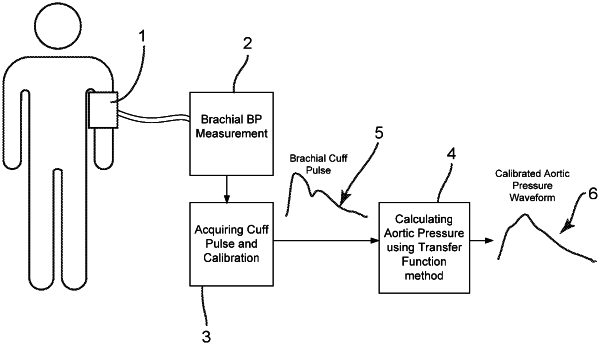| CPC A61B 5/021 (2013.01) [A61B 5/022 (2013.01); A61B 5/0225 (2013.01); A61B 5/7225 (2013.01); A61B 5/7253 (2013.01); A61B 5/742 (2013.01); G16H 10/40 (2018.01); G16H 50/30 (2018.01); A61B 2560/0223 (2013.01); G16Z 99/00 (2019.02)] | 7 Claims |

|
1. In a blood pressure measuring system, a method for determining a calibrated aortic pressure waveform with cardiovascular waveform features preserved, the method comprising the steps:
providing a brachial cuff device having an inflatable brachial cuff, a tube, a pressure pump with a control unit, and a pressure sensor to measure pressure within the inflatable brachial cuff and output an analog signal, said brachial cuff device being capable of measuring a patient's brachial systolic pressure (SPB) and brachial diastolic pressure (DPB) in an oscillometric mode;
providing a digital signal processor comprising an analog to digital converter, a low pass filter and a high pass filter that is capable of receiving an analog signal from the pressure sensor and outputting a digital brachial cuff signal containing data to record the patient's brachial cuff waveform;
measuring at least the patient's brachial systolic pressure (SPB) and brachial diastolic pressure (DPB) using the brachial cuff device in the oscillometric mode;
inflating the inflatable brachial cuff around a patient's upper arm to a constant cuff pressure that is either below the patient's brachial diastolic pressure (DPB) as measured using the brachial cuff device in the oscillometric mode or between the patient's brachial diastolic pressure (DPB) and the brachial systolic pressure (SPB) as measured by the brachial cuff device in the oscillometric mode;
maintaining the inflatable brachial cuff at said constant cuff pressure while the pressure sensor outputs an analog signal that varies based on volumetric displacement within the inflatable brachial cuff;
transmitting the analog signal from the pressure sensor when the cuff pressure is maintained at said constant pressure to the digital signal processor;
processing the analog signal in the digital signal processor through the analog to digital converter and the low pass filter and the high pass filter to output a digital brachial cuff signal containing filtered data that preserves cardiovascular waveform features of the patient's brachial cuff waveform, said cardiovascular waveform features comprising a first shoulder, a second shoulder and an incisura;
using at least two of the patient's brachial systolic pressure (SPB), brachial mean pressure (MPB) and brachial diastolic pressure (DPB) to calibrate the patient's brachial cuff waveform, wherein brachial mean pressure (MPB) if used is determined from the patient's measured brachial systolic pressure (SPB) and the patient's measured brachial diastolic pressure (DPB);
providing software with at least a first a generalized transfer function and a second generalized transfer function that is different from the first generalized transfer function, said first generalized transfer function determined specifically for application to a calibrated brachial cuff volumetric displacement waveform measured by the brachial cuff inflated to a pressure less than a patient's measured brachial diastolic blood pressure, wherein the first generalized transfer function represents the harmonic ratio in amplitude and phase to transform the calibrated brachial cuff volumetric displacement waveform with cardiovascular waveform features preserved to a calibrated aortic pressure waveform with cardiovascular waveform features preserved when the inflatable brachial cuff is inflated to a pressure less than a patient's measured brachial diastolic blood pressure, said first generalized transfer function being determined from simultaneous recordings of brachial cuff volumetric displacement waveform data and central aortic pressure waveform data collected from subjects of a general population with the brachial cuff device used to record the brachial cuff volumetric displacement waveform data when the simultaneous recordings are collected being inflated to a pressure less than the diastolic pressure for the given subject in the general population; said second generalized transfer function determined specifically for application to a calibrated brachial cuff volumetric displacement waveform measured by the brachial cuff inflated to a pressure between a patient's measured brachial diastolic blood pressure and a patient's measured brachial systolic blood pressure, wherein the second generalized transfer function represents the harmonic ratio in amplitude and phase to transform the calibrated brachial cuff volumetric displacement waveform with cardiovascular waveform features preserved to a calibrated aortic pressure waveform with cardiovascular waveform features preserved when the inflatable brachial cuff is inflated to a pressure between a patient's measured brachial diastolic blood pressure and a patient's measured brachial systolic blood pressure, said second generalized transfer function being determined from simultaneous recordings of brachial cuff volumetric displacement waveform data and central aortic pressure waveform data collected from subjects of a general population with the brachial cuff device used to record the brachial cuff volumetric displacement waveform data when the simultaneous recordings are collected being inflated to a pressure between the diastolic pressure and systolic pressure for the given subject in the general population;
selecting the first generalized transfer function if the inflatable brachial cuff is inflated to a constant pressure less than the patient's brachial diastolic pressure and selecting the second generalized transfer function if the inflatable brachial cuff is inflated to a constant pressure between the patient's brachial diastolic pressure and the patient's brachial systolic pressure;
using the software with the selected generalized transfer function to convert the calibrated brachial cuff waveform with cardiovascular features preserved to a calibrated aortic pressure waveform with cardiovascular features preserved for the patient; and
displaying the patient's calibrated aortic pressure waveform with cardiovascular features preserved to enable identification of the first shoulder, the second shoulder and the incisura in the patient's calibrated aortic pressure waveform when it is displayed.
|